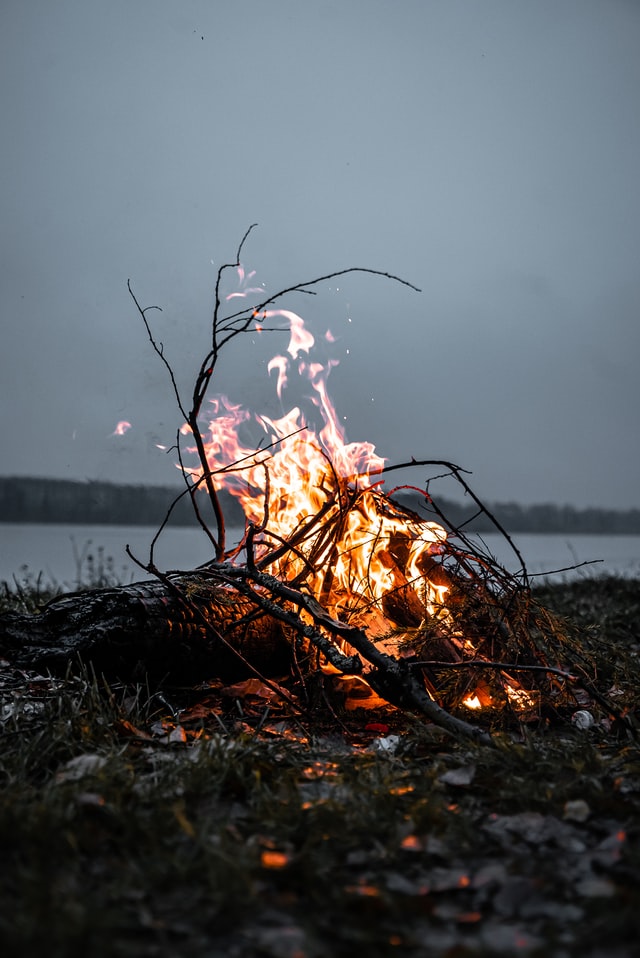This excerpt has been taken from “Firescaping Creating Fire-Resistant Landscapes, Gardens, And Properties in California’s Diverse Environments Wilderness Press Berkeley, CA”. “Tree Removal Berkeley CA” guides you on the Firescaping Monthly Checklist.
Proper timing of tasks is essential to the goals of fire-scaping. Out-of-season maintenance can either encourage or create fires. The effects of pests, storms, and water shortages can be greatly reduced by performing basic, scheduled tasks.
The weather calendar and the month-by month calendar that follows in this section highlight the most important tasks for fire-scaped garden. The first is a graph that illustrates all the work that is weather dependent. The second calendar is a month-by-month checklist. However, a garden’s maintenance costs and chances of ignition can be lowered by doing three common chores-clearing, planting, and pruning-at appropriate times.
Clearing land and removing plants should be done in late winter to early spring. Most plants have not produced seed yet and there may be several months of mind rain left, which will nourish the soil and remaining plants.

Planting in the fall saves water, time, and money. Fall-planted plants are more resilient to summer’s heat and can able be weaned off supplement water more quickly. Naturally, the exceptions to this rule are in the mountains.
Prune trees, shrubs, and ground covers when they will recover the quickest. Every plant has its own unique cycle. Pruning that appreciates these cycles is much more effective. The pruning calendar takes these cycles into account.
January
In the Garden
- Assess the goals of the landscape and develop a plan to reach those goals.
- Remove deadwood created by storms.
- Prune and spray dormant plants, except those that flower early.
- Buy and plant bare-root plants, such as grapes, roses, and fruit trees.
- Clean, sharpen, and replace tools.
- Look for bargains at garden centers.
- Turn the compost pile.
Emergency Preparedness
- List items needed in an emergency, and go out and get them.
- Make a list of phone numbers needed in an emergency.
February
In the Garden
- Look for signs and immediately fix water problems, such as puddling or runoff, which cause rills and gullies. Solutions to erosion and drainage problems are offered .
- Finish spraying or pruning dormant trees and shrubs, except those that flower early.
- Prune roses and grapes.
- Prevent soil compaction by not walking on garden beds until dry, which can takes weeks with clay soils.
- Mulch heavily to suppress weeds.
- Plant summer-flowering bulbs, such as anemone, gladiolus, and tuber begonias.
- Control the early emergence of snails and slugs.
- Control diseases, like peach curl, from last year with either copper or sulfur fungicides.
- Look for bargains at garden centers.
Emergency Preparedness
Pack an emergency kit: radio, first aid kit, flashlight, and three days’ worth of water and food.
Familiarize yourself with local fire codes.
March
In the Garden
- Begin planting in the mountain areas.
- Flush, test, and fix irrigation systems.
- Mow and remove the dead interior of ground covers (de-thatch), such as ivy, hypericum, cape weed, periwinkle, and wild strawberry.
- Reinvigorate lawns by de-thatching, seeding, fertilizing, and mulching.
- Generously apply mulch throughout garden.
- Divide and prune perennials.
- Finish planting summer-blooming bulbs.
- Pull weeds before they can set seed.
- Begin pruning spring –flowering trees and shrubs, such as ceanothus, forsythia, lilac, and viburunum.
- Fertilize productive, domestic landscapes with a high-nitrogen mixture.
Emergency Preparedness
- Check visibility of street name and addresses.
- Volunteer time and money to community cleanup and fuel-removal programs.
April
In the garden
- Reclaim 30 feet of defensible space around the house.
- Continue planting in mountains; start planting frost-sensitive plants.
- Control and guide the flush of spring growth.
- Iron deficiencies are the most obvious right now; fix with either a foliar spray or longer-lasting chelated iron.
- Aphid and snail populations swell; treat as necessary.
- Black spot, sooty mold, rust, and mildew begin to grow again along the coast. Prune out the worst infestations and remove surrounding vegetation to increase sunlight and air circulation. Use fungicides as a last resort.
- Plant transplants of summer annuals and vegetables.
- Prune spring-flowering trees and shrubs, such as ceanothus, forsythia, lilac, and viburnum.
- Last good chance to sow wildflower seeds.
- Pick the first strawberry.
Emergency preparedness
- Call your local fire station and ask for an inspection of the landscape. Having emergency personnel visit a property prior to an emergency will help everyone during any type of emergency.
- Pull together and/or update important documents that will be needed in case you have to flee your home.

May
In the garden
- Keep defensible space clear.
- Only turn water system back on when soil is dry at least 1 foot down.
- Plant summer annuals and vegetables.
- Plant citrus trees.
- Cut non-ornamental grasses to 6 inches.
- Continue to prune spring-blooming shrubs, such as rhododendron.
- Domestic soils may be depleted after spring growth. Fertilize if nutrient deficiencies are visible.
- Sheer or tip plants to create hedges.
Emergency preparedness
- Check and clean garden hoses, fire extinguishers, and auxiliary water pumps.
- Locate the gas shutoff valve and make sure its wrench is within reach of the valve.
June
In the garden
- Begin watering at first signs of water stress.
- Clean up after mid-season fruit drop.
- Loosen the ties that support new trees.
- Protect new trees from sunburn by wrapping vulnerable areas with cloth.
- Monitor and prepare to combat swelling pest populations.
- Prune climbing roses.
- Raise the height of the lawn mowers to 1 inch.
- Pick first wild berry.
- Stop watering native plants.
Emergency preparedness
- Remove any type of ignitable debris around the house and garden.
- Demand that flammable neighbors comply with local fire codes.
July
In the garden
- Native and Mediterranean gardens begin their period of rest, which means little or no water or pruning.
- Cut or pull our unwanted re-sprouting shrubs.
- Mulch zone 1 plants, especially those that are heat sensitive, like rhododendrons and camellias.
- Plant bougainvillea.
- Do not let the weeds go to seed.
- Watch for water stress.
- Control chewing worms.
- Solarize soil where desired.
- Take cuttings of perennials.
- Pick up after fruit trees.
- Good time to tackle construction projects.
Emergency preparedness
- Lay out and hook up emergency equipment, such as hoses and shovels.
- Check ladders and then place close to the house, for easy access to the roof.
August
In the garden
- Keep the landscape surrounding a house well watered and free of deadwood.
- Cut branches 10 feet past chimneys and stovepipes.
- Begin planting winter annuals and vegetables. Plant biennials, such as campanula and foxglove, by seed.
- Let late spring and summer flowers go to seed.
- Prepare a compost pile that will be ready for fall planting.
Emergency preparedness
- Check and oil auxiliary water pumps and emergency; generators.
September
In the garden
- Clean roof and rain gutters. Keep the landscape surrounding a house well watered and free of deadwood.
- Clean fallen fruit and branches.
- Transplant seedlings.
- Prevent debris and leaves from building up to dangerous levels.
- Shop for plants.
- Fertilize domestic landscapes with a complete, low-dosage mixture, such as bone meal, guano, or poultry manure.
- Do not fertilize frost-sensitive plants in frost-prone areas.
Emergency preparedness
- Continue to support community groups and their efforts to reduce fuels.
- With neighbors and/or professional, analyze drainage systems and develop remedies.
October
In the garden
- For landscapes below 3,000 feet, the planting season begins for trees, shrubs, ground covers, season annuals.
- Prune and divide perennials, such as day lilies, callas, yarrow, and salvias.
- Sow wildflower seeds.
- Keep the landscape surrounding a house well watered and free of deadwood.
- Prevent fallen, dried leaves from building up to dangerous levels.
- Over seed warm-season grasses.
- Start looking for snails and slugs again along the coast.
- Order bare-root plants.
- Clean storm drains and gutters. Begin preparing for rain and erosion.
- Prune certain trees, such as cottonwood, maple and sycamore, preparing them winter.
- Severely cut lawns and then mulch.
- Aerate and mulch highly compacted parts of the garden, including footpaths and lawns.
- Let winter dormant plants, like roses, go to seed.
- Reduce watering.
Emergency preparedness
- Conduct a fire drill.
- Keep vigilance over flammable debris around structures.
November
In the garden
- Continue fall planting.
- This is the last month to plant spring-flowering bulbs, such as hyacinth and tulips.
- Cast out wildflower seeds. Lightly stake new trees or those with weak branches.
- Prepare for wind and frost; insulate water and irrigation pipes from a freeze.
- Hire an arborist to evaluate the health of the trees in a landscape.
- Protect outdoor furniture and equipment.
- Clean annuals beds.
- Grab a fig.
- Turn off irrigation systems.
- Start a compost pile that will be ready for spring planting.
- Bare-root plants become available.
Emergency preparedness
- Rent the California department of forestry and fire protection’s California living fire safe video.
December
In the garden
- Protect tender plants from frost and wind.
- Severely prune scraggly perennials and biennials, such as sages, penstemon, grasses, daisies, and Matilija poppies.
- Apply dormant spray to deciduous plants.
- Employ erosion measures against severe rain.
- Weed. It’s exceptionally easy this time of year.
- Turn the compost piles.
- Transplant dormant plants.
- Start shrubs from cuttings.
Emergency preparedness
- Before decorating for the holidays, check and install smoke detectors.
- Check water in cut Christmas trees; live Christmas trees can tolerate only two weeks indoors
Continue reading on Growing Annuals
